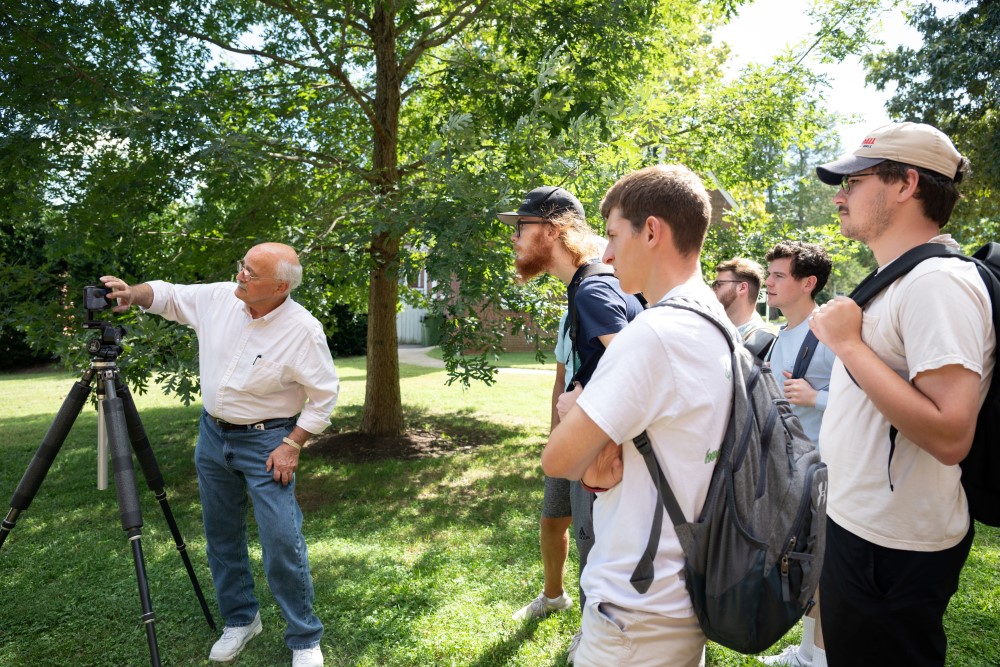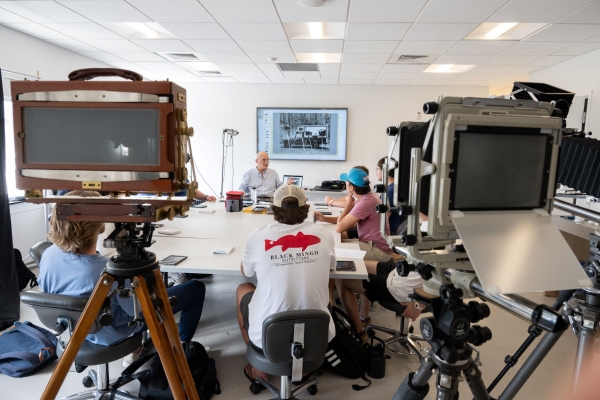 Merriam-Webster Dictionary defines hobby as “a pursuit outside one's regular occupation engaged in especially for relaxation.” For many, photography is considered a hobby, and the likes of teaching it can be considered a hobby as well. This may ring true for many, but for Hampden-Sydney alumnus Brian Grogan ’73, photography is not merely a pastime but a vital means of preserving history, a passion that first took root during his undergraduate years as a history major at Hampden-Sydney.
Merriam-Webster Dictionary defines hobby as “a pursuit outside one's regular occupation engaged in especially for relaxation.” For many, photography is considered a hobby, and the likes of teaching it can be considered a hobby as well. This may ring true for many, but for Hampden-Sydney alumnus Brian Grogan ’73, photography is not merely a pastime but a vital means of preserving history, a passion that first took root during his undergraduate years as a history major at Hampden-Sydney.
“I started photographing as an undergraduate,” Grogan said. “I learned how to process film and create black and white prints in the top floor of Winston Hall [now Brinkley Hall].”
Initially, Grogan had aspirations of pursuing a career in journalism, inspired by his work as an editor of The Tiger and photographer for the newspaper and yearbook, with his eye on National Geographic. After completing his studies, he landed a position at McGraw-Hill Publishing, only to discover that office life did not align with his true calling. Driven by a thirst for knowledge and a love for photography, he embarked on a summer journey to Yosemite National Park to learn from the renowned Ansel Adams, who was conducting photography workshops in the park and introduced him to the world of fine art photography. What was meant to be a brief stay evolved into a more extended period, as Grogan took on a full-time role in human resources at the Yosemite Park & Curry Company, all the while honing his photography skills.
“Gradually, I began to do photography for the National Park Service,” Grogan said. “I assisted in dark room photography, photographed areas around the park, and photographed park events.”
Throughout his photographic journey, Grogan had the privilege of meeting esteemed photographers, including Michael A. Smith. Grogan served as a representative for Smith, assisting in exhibit production, book creation, and showcasing Smith's work across Europe during the 1980s. Grogan's proficiency in French, which he had acquired during his undergraduate study abroad experience in France, played a pivotal role in helping with the success of Smith's photography book, further enriching Grogan's exposure to European photography and career development.
In the late ’80s, Grogan was hired as a staff photographer for the National Park Service. The role required him to capture landscapes, portraits, visitor activities, forest fires, crime scenes, and print historic photographs from the park archives, a point where his interests in photography and history began to collide.
Soon thereafter, Grogan learned about the Historic American Building Survey program of the National Park Service located in Washington, D.C. After some research, Grogan connected with a photographer who worked for the program and received an introduction to the program staff. A year later, Grogan, who was still working at Yosemite, received a call and was informed of the program’s desire to complete a historic documentation project on the historic roads and bridges of Yosemite National Park, with him as the photographer. This marked the beginning of a series of projects that would shape his career.
“For three years, I worked with various teams in the West to photograph and document historic roads and bridges in national parks,” Grogan recalled. “I loved it — it was engaging, technically challenging, and a wonderful way to see many national parks.”
Gradually, the program began to rely on Grogan for project-based photography assignments and started referring federal and private agencies to him, broadening his access to different places, individuals, and types of projects.
“I really enjoy meeting new people and learning about the knowledge they possess,” Grogan smiled. “For me, it’s about being accessible and able to step into the work experience of the people working next to me in the laboratories, on the highway, in military bases, and in the desert while I photograph.”
In his more than 30-year career, Grogan has contributed over 10,000 photographs of historic sites and landscapes captured by his trusty Deardorff view camera to the Library of Congress. Many of his photos were on display in early October at the Atkinson Museum under the exhibit, “Documenting the Cultural Landscape: 50 years Behind a Camera.”

In addition to his Atkinson exhibit, Grogan created a collection of photos from around campus during several extended visits in the ’90s, which are now available to view at the Bortz Library and Pannill Commons. Grogan noted that he enjoyed returning to the Hill throughout the decades since his graduation, capturing the evolving campus and ultimately choosing 45 photos to create the Hampden-Sydney portfolio.
Now back at his alma mater, Grogan has set his sights on sharing his knowledge by teaching the art of documenting historic structures through the lens of a camera. The visual arts course he instructs places a strong emphasis on history, historic preservation, documentation, architecture, archival research, hands-on fieldwork, and, naturally, photography. The course, VISU 285: Special Topics in Visual Arts/Recording Historic Structures delves into the history of programs such as the Historic American Buildings Survey, the Historic American Engineering Record, and the Historic American Landscapes Survey. It also explores various historical documentation standards, including measured drawing, written histories, and large-format photography.
“One important detail I am teaching is visual perception,” Grogan said. “I showed my class my exhibit and assigned them the challenge of finding the locations where I stood when I took photographs on campus twenty-five years ago. It was a great exercise to show how buildings and landscapes transform over time and how buildings age.”
Two major historic structures that Grogan has focused on documenting are the Birthplace and Memorial Gate. Collaborating with his students, Grogan guides them in the process of researching the history, hand-measuring the two structures, creating drawings, and using his large format Deardorff to capture archival photography to create a historic documentation report that will be submitted to the Historic American Buildings Survey for inclusion in the Library of Congress collection, which will name everyone in the course as contributors.
“For around 15 years, I taught in a summer program at the University of Southern California in the School of Architecture where working professionals would earn a certificate in historic preservation,” Grogan said. “Teaching here is a bit different; I’m working with students who do not have professional knowledge of historic preservation, but they are excited to document the history of the Hampden-Sydney campus.”
Grogan noted the importance of the specific documentation standards outlined by the Historic American Buildings Survey. These standards describe the process of taking a correct photo using a view camera, black-and-white film, and archivally processed techniques. These standards also require details about camera placement and where the photograph was taken, thus creating a photographic index.
“I’m bouncing back and forth between lectures related to historic preservation language, protocols, and history of these programs, but the intent is to have the history of these sites written, photographs made, measurements made, and have complete documentation of the Birthplace and Memorial Gate to be submitted to the U.S. Library of Congress as the first structures on campus to be recorded,” Grogan exclaimed. Prince Edward County is full of great history, so I’m happy that we can include Hampden-Sydney history as well.”
“There is this sense of déjà vu returning to campus,” Grogan continued. “I am honored to be invited back and teach this course, and having decades of experience in this work, I often think about my undergraduate days as a history major and bringing my experience full circle. I realized that I am creating art with my photographs and reports, and part of my satisfaction is that I am, in essence, writing history.”
Reflecting on his decades in the field, Grogan says, “It’s all about the stories you are able to tell through the lens.” With yet another fascinating story being told through the lens on Hampden-Sydney’s campus, Grogan and his class will make history, proving to another generation of students that one can accomplish anything with a degree from Hampden-Sydney.